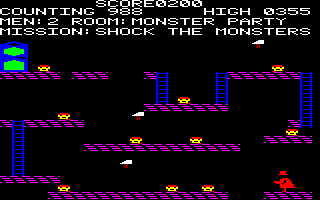
House of Usher is an early platform game made up of nine rooms. You start in the reception hall and pick a door. Each room carries its own challenge with certain aspects of the novel influencing it. This in itself doesn’t always work, though, as some rooms are a nightmare to complete. The graphics look primitive and ultimately do the game no favours at all. The only aspect of this offering that does seem to work is the audio – a spooky, eerie silence throughout the game.
![]() Watch a YouTube video of this game by:
Metr81.
Watch a YouTube video of this game by:
Metr81.
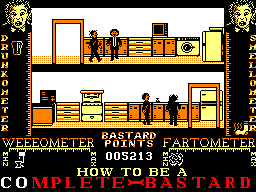
How to Be a Complete Bastard
(Virgin Games, 1987)
Adrian has gatecrashed a yuppie party, and to acquire the honour of being a complete bastard, he has to perform all sorts of misdemeanours to make all the guests leave. Ransacking the house will reveal countless odds and ends; finding out their uses is left to you! In addition, there are four meters – the drunkometer, the weeeometer, the fartometer, and the smellometer – which are all self-explanatory. However, there are some things you can only do when you’re sober, and other things you can only do when you’re drunk. The nature of the game is initially appealing, especially to adolescents, but the way that the rooms are viewed is very confusing, and it’s so slow that you’ll switch off within minutes.
![]() Watch a YouTube video of this game by:
Xyphoe.
Watch a YouTube video of this game by:
Xyphoe.
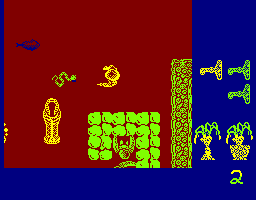
The story behind this game is that you play a nerdy guy who, in order to discover what it takes to be a hero, is thrust by his super-hero teacher into several heroic situations, to see how much of a hero he is. Sounds good, but in reality the story doesn’t play an important part in the game at all; it’s just three levels of dull, very hard dungeon-roaming viewed from above. The first level is set in an Egyptian tomb and you must find keys and various treasures, shoot the obscene amount of bad guys (scorpions, spiders etc.) who never seem to die, and find the exit to the next level – another tomb. The graphics are bad, and the sound is pathetic. More like How to Be a Zero!
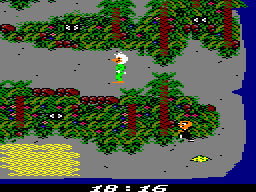
Howard the Duck
(Activision, 1987)
Howard the Duck has been parachuted on to Volcano Island, where the Dark Overlord has imprisoned Beverly and Phil. Howard must collect his gear and head for the volcano to ultimately destroy the Dark Overlord using the deadly Neutron Disintegrator. Once you have worked out how to jump over the mutant slime and collected your gear, you can fly across the river in your solar-powered jetpack (I thought ducks could swim?) and use your mastery of Quack Fu to kill any mutants on your way to the volcano. The game is based on a comic book character, who later appeared in a well-known turkey of a film of the same name. This is a turkey as well, with mediocre graphics and little or no thought having been given to the gameplay, which is incredibly dull, simplistic and tedious.
![]() Watch a YouTube video of this game by:
Metr81.
Watch a YouTube video of this game by:
Metr81.
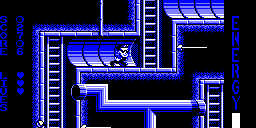
Hudson Hawk
(Ocean, 1991)
Eddie ‘Hudson’ Hawkins’ friend has been captured by a gang, who force Eddie to steal three works of art made by Leonardo da Vinci in order to build a machine that will turn lead into gold. If he refuses to comply, the gang will kill his friend. The film that this game is based on was a major flop, but the game itself is not bad. It’s a platform game with some puzzle elements to it; for instance, you will have to work out how to reach a high window, climb over large boxes (Hudson’s a small fellow in this game), or avoid being caught by security cameras. Graphically it’s brilliant, albeit very blue indeed, although there is no music and little in the way of sound effects. It’s an easy game to get into and is worth trying out, even if Hudson’s movements are a little sluggish.
![]() Watch YouTube videos of this game by:
Axelino,
jgonza,
Xyphoe.
Watch YouTube videos of this game by:
Axelino,
jgonza,
Xyphoe.
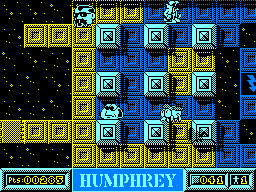
This is a game I used to like when I was younger, but which has since lost much of its attractiveness. You take the control of a strange-looking guy named Humphrey. When Humphrey walks on the ground tiles, they change colour, and you must step on all of them to clear the stage. Of course, a plethora of creatures spend their time chasing you, while flying bugs only expect you to jump so they can sting you to death. Some tiles move to take you to inaccessible places, while others crumble under your steps or explode. The graphics are not too bad, but the sound effects hardly exist and the animation is slow. Besides, you often get stuck when getting round an obstacle, which does not simplify your task.
![]() Watch a YouTube video of this game by:
Amstrad CPC World.
Watch a YouTube video of this game by:
Amstrad CPC World.
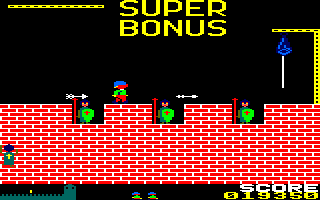
Hunchback
(Amsoft/Ocean, 1984)
Esmeralda has been captured and Quasimodo the hunchback must rescue her. As Quasimodo, you must jump over the obstacles on the ramparts, dodging spears, arrows and fireballs, and leaping across chasms. Watch out for the knight who is climbing the walls and chasing after you! This was one of Ocean’s earliest releases for the CPC. I suppose the game was good for its time, but it feels really old and dated nowadays. Obviously, the graphics are poor and unappealing, but the gameplay totally lacks any excitement. It doesn’t have the nostalgia of some of Amsoft’s other titles – even if they were bad as well.
See also: Hunchback II, Hunchback: The Adventure.
![]() Watch YouTube videos of this game by:
ChinnyVision,
GameHammer Classic Gaming,
Xyphoe.
Watch YouTube videos of this game by:
ChinnyVision,
GameHammer Classic Gaming,
Xyphoe.
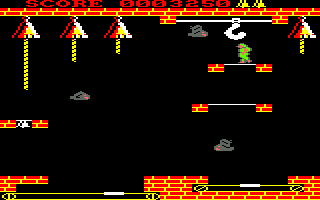
Hunchback II
(Ocean, 1985)
Esmeralda has been captured again, so Quasimodo sets out to rescue her again. As in the previous game, you must dodge various hazards, but this time, it’s a proper platform game in which you can move all around the screen. Your aim on each of the five screens is to collect all the bells on the platforms. To move from one platform to another, you can either jump or use the ropes on the large bells. However, it’s rather hard, and pixel-perfect precision is often required. The graphics are OK for their time, and the jingles when you start a new game and complete a level are very jolly, but the actual gameplay isn’t particularly endearing to me.
See also: Hunchback, Hunchback: The Adventure.
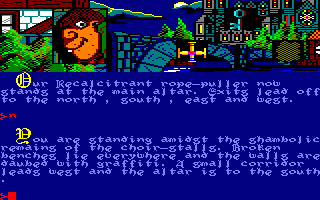
This is a very snazzy-looking text adventure, in which you take the part of deformed bell-ringer Quasimodo, and must ultimately rescue Esmeralda from the clutches of the evil Cardinal. First though, you must escape from the maze-like and heavily guarded Notre Dame Cathedral, before taking to the sewers beneath Paris. It’s not a difficult game, but it can get frustrating with its maze-like layout, and you’ll often find yourself wandering about in circles. On top of that, the parser is quite limited, with a lack of obvious commands such as ‘talk’ and ‘examine’, which detracts from the depth of the game somewhat. Stick with it, though, and you’ll be pleasantly surprised. It’s lovely to look at, is challenging but not difficult, has a great sense of humour and is quite lengthy.
See also: Hunchback, Hunchback II.
![]() Watch a YouTube video of this game by:
XeNoMoRPH.
Watch a YouTube video of this game by:
XeNoMoRPH.
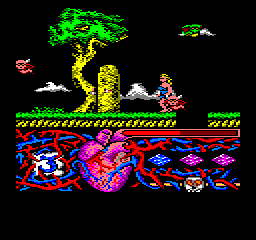
Hundra
(Dinamic/Mastertronic, 1988)
The Viking king Jorund has been captured and is being held by the Viking gods somewhere in the kingdom of Lukx. Jorund’s daughter, Hundra, must enter the kingdom and rescue him. As Hundra, you must collect three precious jewels in order to rescue Jorund. The first isn’t too difficult to find, but you’ll need two keys to collect the others, and you can’t collect the circular key until you’ve found the triangular key. This isn’t a bad platform game by any means, and the graphics are colourful and appealing. However, there are numerous traps which are frustratingly difficult to avoid, meaning that lives are needlessly wasted. Despite this, it’s still possible to explore most of what is a fairly good game.
![]() Watch YouTube videos of this game by:
jgonza,
Metr81,
Retro Danuart.
Watch YouTube videos of this game by:
jgonza,
Metr81,
Retro Danuart.
